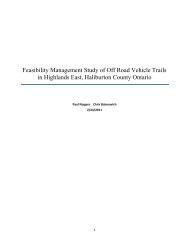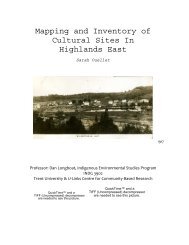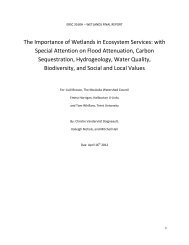Untitled - Haliburton County Community Cooperative Inc
Untitled - Haliburton County Community Cooperative Inc
Untitled - Haliburton County Community Cooperative Inc
- No tags were found...
Create successful ePaper yourself
Turn your PDF publications into a flip-book with our unique Google optimized e-Paper software.
to most. For this reason it will be assumed that smallmouth bass are native to all lakes that currentlysustain populations of the species.While many lakes in the region support healthy, self-sustaining populations of smallmouth bass,it is necessary to understand the aquatic food chain that smallmouth bass depend on in order to thrive.Unlike walleye and northern pike, smallmouth bass generally feed on crayfish and cyprinids, and rely onthese species in most lakes for a large portion of their diet, thereby making crayfish and cyprinids ofgreat importance to the local economy (Cabana et al, 1994). The invasive rusty crayfish, (Orconectesrusticus) has invaded many lakes in the state of Wisconsin and has changed the littoral zones in severalof these lakes by reducing macrophyte abundance and lakes with high densities of crayfish can undergodrastic ecological changes (Roth et. al 2007). It has also been suggested that smallmouth bassselectively consume fewer rustic crayfish than there native forage such as O. propinquus or O. virilis(Roth & Kitchell, 2005). In order to ensure that smallmouth bass numbers do not decline as a result oflost habitat due decreases in macrophyte densities or decreases in overall health due to loss of forage,we must ensure that value is given to crayfish and other cyprinids (Roth et al ,2007)If the number of smallmouth bass were to decrease drastically over a relatively short period oftime, this could greatly impact the fishing industry in the area. In 2005 almost 2 million smallmouth basswere caught in Zone 15 alone, and they (smallmouth bass) are one of the most sought after recreationalspecies in the region (Hogg et al, 2010). Due to angler success in the region, over 70% of recreationalanglers rated their fishing experience as “good”, “very good”, or “excellent”, and it is likely thatsmallmouth bass are responsible for a large portion of these responses (Hogg et. al 2010). If peopleexperience “good” or better angling success in the area, it is likely that they will return to the area in thefuture or perhaps even invest in property, fishing gear such as boats and rods, and the revenuegenerated by the fishing industry will continue to grow. For this reason, It is estimated that 15% of thetotal money spent annually on recreational fishing in Zone 15 relies on the smallmouth bass fishery in31







